PLATED AND ELECTROPLATED SILVER MARKS OF FRANCE DOUBLÉ, PLAQUÉE, METAL, METAL BLANC, MÉTAL ARGENTÉ -A - B- |
|
created by Giorgio B. owner of www.silvercollection.it ©  |
This is a page of A Small
Collection of Antique Silver and Objects of vertu, a 1000
pages richly illustrated website offering all you need to know
about antique silver, sterling silver, silverplate, sheffield
plate, electroplate silver, silverware, flatware, tea services
and tea complements, marks and hallmarks, silver marking system and silver
hallmarks guide, articles, books,
auction catalogs, famous silversmiths (Tiffany, Gorham, Jensen,
Elkington, WMF, Reed & Barton, Mappin & Webb, Bateman Family),
history, oddities ... |
|
|
French solid silver is characterized by series of hallmarks and the presence of the maker's mark in a lozenge/diamond-shaped cartouche. On plated metal a square or rectangular cartouche is used for maker's mark. From 1797 the mark of the "métal plaqué", equivalent to British "Old Sheffield Plate", was a square or rectangular cartouche containing: - the initials of the maker - the word "DOUBLÉ" or "PLAQUÉ" - the figure indicating the quantity of silver (optional) The thickness of silver was indicated by a number followed by a small "E", "M" or "EM", as abbreviation of Dixième (Tenth). The number represented the percentage of silver relative to the base metal (higher numbers are indicative of the poorest quality of plating) |




|
From 1860, to differentiate the "métal plaqué" from the "argenture par dépôt électrolytique", equivalent to British EPNS (Electro Plated Nickel Silver), were used square marks containing: - the initials of the maker and the figure indicating the quantity of silver |

|
- the initials of the maker, a symbol and the figure indicating the quantity of silver |


|
- the initials of the maker and a symbol accompanied by another cartouche containing the figure of the silver content |


|
Sometimes they are accompanied by additional marks with the inscription "METAL" or "METAL BLANC" (WHITE METAL) |

 |
|
|
MÉTAL ARGENTÉ |
| To strengthen consumer protection, the French Parliament voted on July 1, 1983 a law which reformed the Guarantee and codified the conditions of silver hallmarking. In this context it was decided to measure the thickness of silver deposited on the entire surface and to institute minimum standard thicknesses for silverplate. The old mark expressed in grams, which is not compulsory, remains in use. Often it indicates silver weights greater than the new imposed standards. The new square hallmark (applicable from August 1984) therefore guarantees the thickness of the silver layer deposited on the item. The POINÇON CARRÉ is the official mark for "métal argenté". It is a square containing: - I or II, identifying the first or second quality of manufacture - a symbol identifying the maker - the initials of the maker 

|
These are the requirements to be allowed to use the "POINÇON CARRÉ" mark and "métal argenté" denomination (plating thickness is measured in Micrometers: a micron is one thousandth of a millimeter or 0.001mm). 
|
|
|
NUMBERS IN FRENCH SILVERPLATE |
| The meaning of numbers in French silverplate marks has changed over time: 1797 - c. 1860 number accompanied by "E", "M" or "EM" (meaning Dixiéme / tenth) in the upper right corner. This number is the percentage of silver used to plate the copper ingot (plating was made using the system known in the UK as "Old Sheffield Plate") c. 1860 - 1983 number alone or accompanied by "G" or "GR". This is the number of grams of silver used to plate a single item or a dozen of spoons or forks (referred to the process of silver electroplating which has supplanted the OSP system) after 1983 "Roman" numbers I or II in a corner. This number identifies the first or second quality of "métal argenté". The quality of the plating is determined by the microns of silver present on the item (a micron is one thousandth of a millimetre or 0.001mm). |
|
FRENCH SILVERPLATE MARKS DIRECTORY BY INITIALS/SYMBOLS DIRECTORY BY NAMES MAKER'S MARK INITIAL: A - B - C - D - E - F - G - H - I - J - K - L - M - N - O - P - Q - R - S - T - U - V - W - X - Y - Z - |
FRENCH SILVERPLATE MAKERS' MARKS |
 AB and a crescent and four stars / un croissant et quatre étoiles 




 Boulenger Adolphe, 4 rue du Vert-Bois, Paris, active 1876-1899
Boulenger Adolphe, 4 rue du Vert-Bois, Paris, active 1876-1899AB and a bumblebee / un bourdon 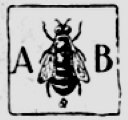 Alexandre & Bourdon, 45 rue de Verbois, Paris, active c. 1900
Alexandre & Bourdon, 45 rue de Verbois, Paris, active c. 1900AC and a crowned cross of honor / une croix d'honneur couronnée  Cardeilhac Amélie, 24 place Vendôme, Paris, active 1914-1920
Cardeilhac Amélie, 24 place Vendôme, Paris, active 1914-1920AC and an anchor / une ancre 
 Maker not identified
Maker not identifiedAC and a lyre / une lyre  Caploun André, rue Pasturelle and rue de Turenne, Paris, active from 1921. in 1893/1896 in rue de Turbigo was active Clément-Auber who used a similar mark
Caploun André, rue Pasturelle and rue de Turenne, Paris, active from 1921. in 1893/1896 in rue de Turbigo was active Clément-Auber who used a similar mark AD and a woodcock / une bécasse  Debain Alphonse, 79 rue du Temple, Paris succeeding to Philippe Berthier, active 1883-1911
Debain Alphonse, 79 rue du Temple, Paris succeeding to Philippe Berthier, active 1883-1911AD and a lion / un lion (the shaking hands is the "poinçon de bonne foi"/good faith mark) 
 Derivry Auguste, 52 rue de Bondy, Paris, active from 1923
Derivry Auguste, 52 rue de Bondy, Paris, active from 1923
AD and a hammer and a wooden peg / un marteau et une mirette en bois 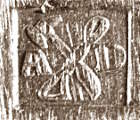 Dahl Aksel, 3 rue de la Perle, Paris, active from 1921
Dahl Aksel, 3 rue de la Perle, Paris, active from 1921
AF and an anchor / une ancre 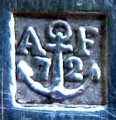



 Frenais Armand, 77 boulevard Richard-Lenoir, Paris, active 1877-1927
Frenais Armand, 77 boulevard Richard-Lenoir, Paris, active 1877-1927Succeeded to Franche & Frenais maintaining in early times the old mark next to the "anchor" mark 
AF and a half moon / un croissant 
 Frionnet Albert / A. Frionnet & Cie, 8 rue des Quatre-Fils, Paris, active 1907-1944
Frionnet Albert / A. Frionnet & Cie, 8 rue des Quatre-Fils, Paris, active 1907-1944Factories at 2 rue du Foin and 5 rue de Béarn, Paris and 36 rue de Lyon, Thiers (P. de D.). Succeeded by Frionnet François AG and a bag / une bourse  Gudin Adolphe, 1 rue Castex, Paris, active 1920-1922
Gudin Adolphe, 1 rue Castex, Paris, active 1920-1922
AG and a symbol / un symbole 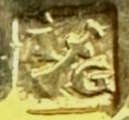 A. Gelb, La Queue-en-Brie, active c. 1940 (possibly)
A. Gelb, La Queue-en-Brie, active c. 1940 (possibly)
AL and a symbol / un symbole  Maker not identified
Maker not identified
AL a crescent, a star in the middle / un croissant, une étoile dans le milieu  Leclerc Aristide, 10 rue Sainte-Anastase, Paris, active from 1900
Leclerc Aristide, 10 rue Sainte-Anastase, Paris, active from 1900
AL and two crossed cutlery / deux couvert en croix 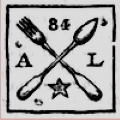 Lejeune A., 83 rue du Temple, Paris where A. Ravinet acted as a section of Lejeune (c.1900)
Lejeune A., 83 rue du Temple, Paris where A. Ravinet acted as a section of Lejeune (c.1900)
ALFENIDE and a goat / une chèvre 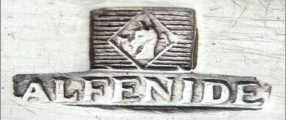 Alfenide a trade mark of Christofle
Alfenide a trade mark of Christofle
A.LOISEAU & Cie 

 A.Loiseau & Cie, rue de la Madeleine, Besançon, late 19th/early 20th century
A.Loiseau & Cie, rue de la Madeleine, Besançon, late 19th/early 20th century
ALPACCA and a mouse / un rat  Société des Couverts de Mouroux, 8 rue d'Angoulémee, Paris and 7 rue des Rochottes, Darney, Mouroux (factory), active from 1895
Société des Couverts de Mouroux, 8 rue d'Angoulémee, Paris and 7 rue des Rochottes, Darney, Mouroux (factory), active from 1895
AM and a mallet / un maillet 
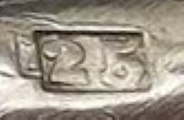 Mailhan, 27 rue Aubry-le-Boucher, Paris, active from 1883
Mailhan, 27 rue Aubry-le-Boucher, Paris, active from 1883
AP and a horse's head / une tête de cheval  Philippe Alfred, 112 rue du Temple, Paris, active c. 1921. Succeeded by Louis Philippe c. 1926
Philippe Alfred, 112 rue du Temple, Paris, active c. 1921. Succeeded by Louis Philippe c. 1926
AR and a wheel / une roue  Roberge André, 15 rue de Montmorency and 4 rue de l'Entrepôt, Paris, active 1918-1924
Roberge André, 15 rue de Montmorency and 4 rue de l'Entrepôt, Paris, active 1918-1924
ARDJ and a cross / une crosse  Crossard Joseph, 36 rue de Montmorency, Paris, active 1900-1920
Crossard Joseph, 36 rue de Montmorency, Paris, active 1900-1920(succeeded by Crossard & Dogit 1920-1931) AS and a ram's head / une tête de mouton  Soulat Auguste, 25 rue Michel-le-Comte and 103 rue du Temple, Paris, active from 1907
Soulat Auguste, 25 rue Michel-le-Comte and 103 rue du Temple, Paris, active from 1907
AU BON MARCHÉ  Au Bon Marché, a department store, Paris, active from c.1865
Au Bon Marché, a department store, Paris, active from c.1865
 BAILLIER  Maker not identified
Maker not identified
B.B into a square BB into a square BB into a crown 



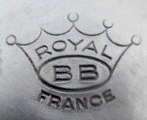

 Bouillet & Bourdelle, 163 cours Émile Zola, Lyon-Villeurbanne, active 1896-present
Bouillet & Bourdelle, 163 cours Émile Zola, Lyon-Villeurbanne, active 1896-presentOwners of flatware factory Cailar-Bayard. Store and flatware factory in Paris, 37-39 rue Grange-aux-Belles. The "ROYAL BB into a crown" trademark was registered in the USA (Serial number 73411227) B Cie and a bicycle wheel / une roue de bicyclette  Brosse & Cie, 7 rue Froissart, Paris, active c. 1910
Brosse & Cie, 7 rue Froissart, Paris, active c. 1910
BJ and a crayfish / une écrevisse  Nadal, 19 rue de Poitou, Paris, active c. 1900. Successors to Maison de Jarcy
Nadal, 19 rue de Poitou, Paris, active c. 1900. Successors to Maison de Jarcy
B.P into a shield, under a star / dans un blason avec une étoile  Pottecher & Cie, Bussang, Vosges
Pottecher & Cie, Bussang, VosgesFounded in 1838 by Benjamin Pottecher. Trade mark ÉTOILE |
|
FRENCH SILVERPLATE MARKS DIRECTORY BY INITIALS/SYMBOLS DIRECTORY BY NAMES MAKER'S MARK INITIAL: A - B - C - D - E - F - G - H - I - J - K - L - M - N - O - P - Q - R - S - T - U - V - W - X - Y - Z - |
REPERTOIRE DES ORFEVRES FRANCAIS AA AH B CA CG D EA EJ F GA GH HA HG I JA JH K LA LH MA MH N O PA PH Q R S T U V W X Y Z |
|
This is a page of A Small Collection of Antique Silver and Objects of vertu, a 1500 pages richly illustrated website offering all you need to know about antique silver, sterling silver, silverplate, sheffield plate, electroplate silver, silverware, flatware, tea services and tea complements, marks and hallmarks, articles, books, auction catalogs, famous silversmiths (Tiffany, Gorham, Jensen, Elkington, WMF, Reed & Barton, Mappin & Webb, Bateman Family), history, oddities ... SITE MAP SILVER DICTIONARY |